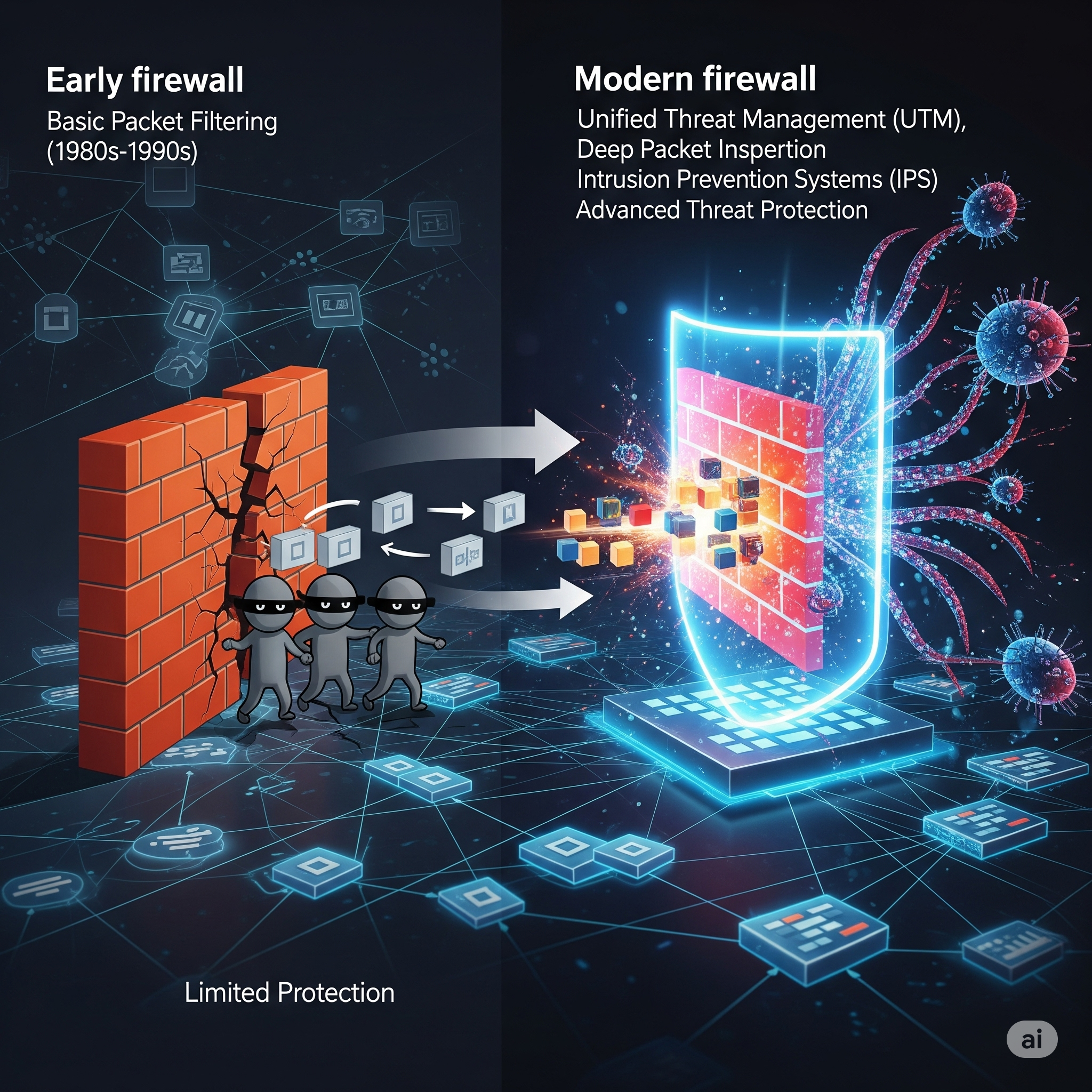Firewalls

The Evolution of Firewalls
The Evolution of Firewalls: From Network Gatekeepers to AI-Powered Defenders
(A Vendor-Neutral Technical History)
1. The Pre-Firewall Era (1970s–Early 1980s)
- Problem: Early networks like ARPANET operated on implicit trust—no traffic filtering existed.
- Key Event: The 1988 Morris Worm (one of the first large-scale cyberattacks) exposed the need for traffic controls.
- Solution Seed: Researchers at Digital Equipment Corp (DEC) developed the first packet-filtering concepts in 1988.
2. First-Generation Firewalls: Packet Filters (Late 1980s)
- Technology: Basic ACLs (Access Control Lists) on routers.
- How It Worked: Filtered traffic based on source/destination IP and ports (Layer 3/4).
- Limitation: No state tracking—easily bypassed by IP spoofing.
- Example: Cisco’s ACLs, early Unix
ipfw.
3. Second-Gen: Stateful Inspection (1990s)
- Innovator: Check Point’s *FireWall-1* (1993) popularized stateful tracking.
- Breakthrough: Maintained a state table to validate if packets belonged to legitimate sessions.
- Impact: Stopped unsolicited inbound traffic (e.g., port scans).
- Limitation: Still blind to application-layer threats (e.g., HTTP exploits).
4. Third-Gen: Application/Proxy Firewalls (Late 1990s)
- Driver: Rise of web-based attacks (e.g., Code Red worm, SQL injection).
- Technology:
- Proxy Firewalls: Terminated and rebuilt connections (e.g., SOCKS proxies).
- Deep Packet Inspection (DPI): Analyzed Layer 7 (HTTP, FTP) content.
- Trade-off: High latency due to full packet inspection.
- Example: Netscreen, Squid Proxy.
5. Next-Generation Firewalls (NGFW) (2000s)
- Core Features:
- Combined stateful inspection + DPI + IDS/IPS.
- Application Awareness: Policies based on apps (e.g., Facebook vs. SAP).
- User-ID: Policies tied to AD/LDAP users, not just IPs.
- Pioneers: Palo Alto Networks (2007), Fortinet.
- Use Case: Blocked malware hidden in allowed ports (e.g., HTTPS tunneling).
6. Modern Era: Cloud, AI, and Zero Trust (2010s–Present)
- Trends:
- Cloud Firewalls: AWS Security Groups, Azure Firewall.
- Threat Intelligence: Integration with global threat feeds (e.g., STIX/TAXII).
- AI/ML: Behavioral analysis to detect zero-day attacks.
- Zero Trust: Micro-segmentation (e.g., Google BeyondCorp).
- Examples:
- Cloud-Native: Zscaler, Cloudflare Magic Firewall.
- Hybrid: Cisco Firepower, Juniper SRX.
Future Directions (2025+)
- Autonomous Firewalls: Self-healing rules via AI.
- IoT/OT Focus: Protecting industrial systems.
- Post-Quantum: Encryption-resistant firewalls.
Why Firewalls Keep Evolving
| Decade | Threats | Firewall Response |
|---|---|---|
| 1980s | Basic worms | Packet filtering |
| 1990s | IP spoofing, port scans | Stateful inspection |
| 2000s | Web exploits, malware | NGFW (DPI, app control) |
| 2010s | APTs, encrypted threats | SSL inspection, sandboxing |
| 2020s | Cloud, zero-day, AI attacks | AI-driven analytics, Zero Trust |
Key Takeaways
- Security vs. Usability Trade-offs: Early firewalls sacrificed granularity for performance; modern NGFWs balance both.
- Shift from Perimeter to Identity: Firewalls now enforce policies based on who you are, not just where you’re connecting from.
- Convergence with Other Tools: Today’s firewalls integrate with SIEM, EDR, and cloud-native security platforms.
Amin
0
Tags :
